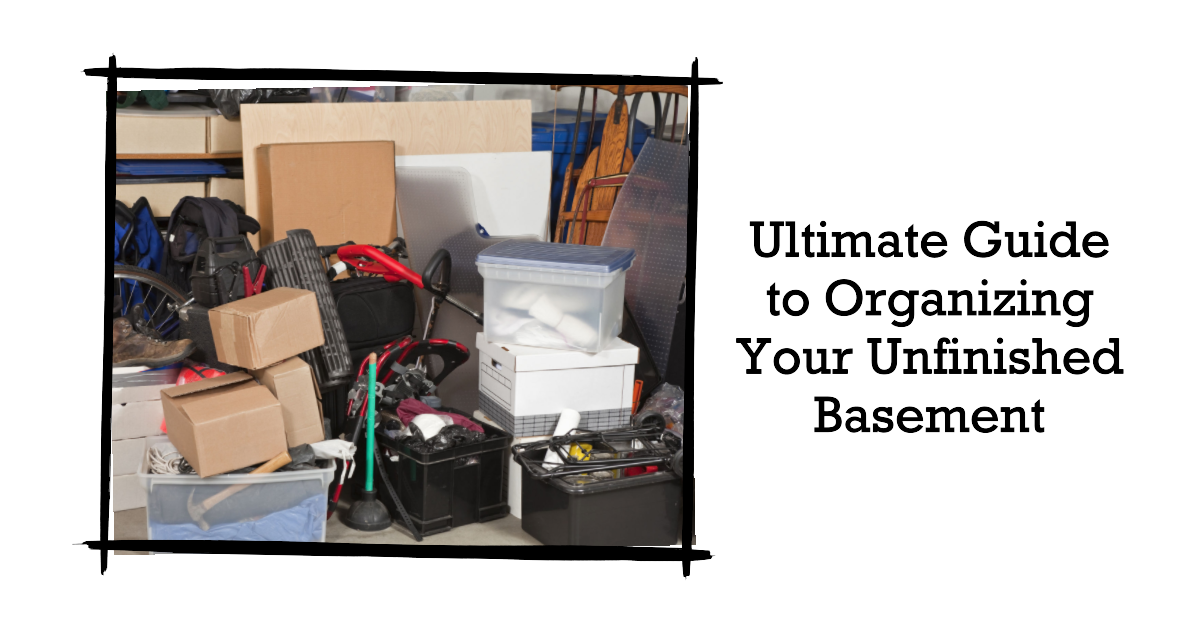I am a well-rounded expert with proficiency in several fields. My experience spans from being a dedicated chef and homemaker. As a passionate homesteader, I’ve honed my skills in sustainable living and animal care, ensuring a holistic approach to everything I undertake. Email me or Txt: (# removed due to spam, please email)
Organizing an unfinished basement can be a daunting task, but with the right approach, it can be both manageable and rewarding.
A well-organized basement offers extra storage space, reduces clutter, and can even increase the value of your home.
This article will guide you through the process of organizing your basement and offer tips on how to maintain an organized space.

Assessing Your Unfinished Basement
Before diving into the organization process, it’s essential to assess the current state of your basement. Take note of the types of items stored there, such as tools, seasonal decorations, and clothing.
Also, determine how much storage space is available, including shelves, cabinets, and other storage solutions.
In addition to assessing the items and storage solutions, it’s important to evaluate the condition of the basement itself.
Check for any signs of moisture or water damage, such as damp spots or mold growth. Look for any cracks in the walls or floors that may indicate structural issues.
Finally, assess the lighting and airflow in the space to determine if any improvements need to be made. By taking the time to assess your basement, you can develop a more effective plan for organizing and optimizing the space.

Sorting and Decluttering Your Basement
The first step in organizing your basement is to sort through the items and declutter. Create categories for your items, such as tools, holiday decorations, and children’s toys.
As you sort, consider donating, selling, or discarding items you no longer need or use. This process will make it easier to organize the remaining items and reduce basement clutter.
it’s important to be honest with yourself about what you realistically need and use. Ask yourself questions like “Have I used this in the last year?” and “Is this item still in good condition?” If the answer is no, it may be time to let it go.
Another helpful tip is to use the “four box method.” Label four boxes: keep, donate, sell, and discard. As you sort through your items, place them in the appropriate box.
This method can help streamline the decluttering process and make it easier to decide what to do with each item.
It’s also important to involve the entire family in the sorting and decluttering process. This can help ensure that everyone is on the same page and that no items are mistakenly thrown away or kept when they should be donated or sold.

Implementing Basement Organization Hacks
To maximize your basement’s storage potential, consider implementing the following organization hacks:
- Use vertical storage solutions, such as wall-mounted shelves and pegboards, to maximize space.
- Opt for unconventional storage options, like under-stair storage or repurposed furniture.
- Create designated zones for different purposes, like a play area, home gym, or workspace.
- Label and categorize items for easy retrieval, using labels, bins, and storage containers.
- Use clear storage containers to make it easy to identify what’s inside without having to open every box.
- Install sliding storage systems under stairs or shelves for easy access to stored items.
- Maximize unused ceiling space with overhead storage solutions, like hanging racks or shelves. (use caution!)
- Use hooks or hangers to hang frequently used items, such as tools or sports equipment.
- Invest in furniture that doubles as storage, such as a storage bench or ottoman.
- Create a system for maintaining your organization, such as a monthly or seasonal decluttering routine.

Organizing Tools and Equipment
Proper organization of tools and equipment can make DIY projects more efficient and enjoyable. Use pegboards and hooks to keep tools easily accessible, install shelves and cabinets for additional storage, and designate a workspace for projects.
You can also consider using a toolbox or tool chest to keep smaller tools organized and easily transportable.
Label drawers or compartments so you can quickly find what you need. For larger tools, such as lawn mowers or snow blowers, consider installing wall-mounted racks or ceiling hoists to keep them out of the way when not in use.
Finally, regularly maintain and clean your tools to prolong their lifespan and ensure they are ready for use when you need them.
It’s essential to keep the weight and size of tools and equipment in mind when organizing them in the basement. If you plan to bring them upstairs frequently, consider storing them in a location that’s easily accessible and manageable.
Investing in a sturdy utility cart or dolly can help make the process of moving tools and equipment more manageable.

Organizing Seasonal Items and Decorations
Organize seasonal items and decorations by storing them in clear plastic bins, labeling the contents, and establishing a rotation schedule.
Create a designated area for holiday decorations to keep them separate from other items.
Using a shelving unit with multiple levels can help maximize vertical space and allow you to store more items in a smaller footprint.
Consider using specialty containers, such as ornament storage boxes or wrapping paper holders, to protect delicate decorations and keep everything organized.
When not in use, stack bins and containers to save space. Finally, consider purging decorations and items that you no longer use or need to keep the storage area clutter-free.
We all have those cluttered ripped up decorations we never seem to throw away.

Organizing Clothing and Linens
Storing off-season clothing in vacuum-sealed bags is an excellent way to save space and protect garments from moisture and pests.
These bags are available in a range of sizes and can be easily sealed with a vacuum cleaner, which removes all of the air from the bag, compressing the contents inside.
This method of storage is particularly useful for bulky items like winter coats, sweaters, and heavy blankets.
To further protect your clothing, consider adding moisture-absorbing products, like silica gel packets or moisture-absorbing crystals, to the bags before sealing them.
This will help prevent mildew and mold from developing on your garments while they are in storage.
Organizing linens and bedding is another crucial aspect of basement organization. Start by grouping items by type and size.
For example, keep all of your sheet sets together, sorted by bed size, and then organize your towels by size and color.
By following these simple steps, you can keep your clothing and linens organized, protected, and easily accessible in your basement.

Maintaining Your Organized Basement
Once your basement is organized, it’s crucial to maintain the order. Establish a cleaning and maintenance schedule, regularly declutter and reorganize, and encourage family members to participate in maintaining organization.
- Regularly declutter and reorganize: To prevent clutter from accumulating in your organized basement, regularly declutter and reorganize your items. Set a schedule to review and assess the items you have stored in the basement. Discard any items that you no longer need or use. Reorganize the remaining items and make sure everything is in its designated place.
- Encourage family members to participate: Get your family members involved in maintaining the organization of your basement. Assign tasks and responsibilities to each family member, so everyone is accountable for keeping the space tidy. Make it a fun and collaborative activity by setting a timer and challenging each other to complete the tasks within a certain time frame.
- Use storage solutions to maintain order: Continue to use storage solutions like shelves, cabinets, and bins to keep your items organized. Label each storage container, so you know exactly what’s inside, and make sure to return items to their designated storage space after each use.
- Keep up with repairs: Regularly inspect your basement for any signs of damage or wear and tear. Address any issues promptly to prevent them from getting worse. This could include repairing leaks, fixing broken shelves or cabinets, or replacing damaged flooring.

Minimizing Risks
When it comes to organizing and maintaining your basement, it’s important to prioritize safety and minimize risks. Here are some tips to help you do so:
- Implement fire prevention measures: Basements are at a higher risk of fires due to their location and potential for flammable items being stored there. Make sure to install smoke detectors and fire extinguishers in your basement. Avoid overloading electrical outlets, and keep flammable items like papers, chemicals, and cleaning products away from heat sources.
- Ensure proper ventilation: Poor ventilation can lead to the accumulation of harmful fumes and pollutants, such as carbon monoxide. Make sure to have proper ventilation in your basement by installing exhaust fans or opening windows when possible. Consider having your furnace and water heater inspected regularly to ensure proper ventilation.
- Control moisture: Basements are prone to moisture, which can lead to mold and mildew growth, as well as structural damage. Install a dehumidifier to control humidity levels and prevent moisture buildup. Make sure to address any leaks or water damage promptly to prevent further damage.
- Store hazardous materials correctly: If you store hazardous materials in your basement, make sure to store them correctly and label them properly. Keep them in a well-ventilated area, away from heat sources, and store them in their original containers.
In addition to the tips mentioned above, it’s important to avoid storing heavy objects in the voids above where people walk.
These spaces, commonly found in unfinished basements, can be tempting for storage, but heavy items can pose a risk if they fall or collapse.
The last thing you want is your child or family member getting seriously injured or worse.
Instead, opt for storing lighter items in these areas or consider installing flooring to create a safe and stable surface.
It’s crucial to prioritize safety in all aspects of basement organization to prevent accidents or injuries.
By implementing these measures, you can minimize risks and ensure the safety of your basement. Regularly inspect and maintain these safety measures to ensure they are working correctly and efficiently.

Conclusion
Organizing an unfinished basement can be challenging, but with the right strategies and organization hacks, it can become a functional and efficient space. Embrace the process and enjoy the benefits of a well-organized basement.



